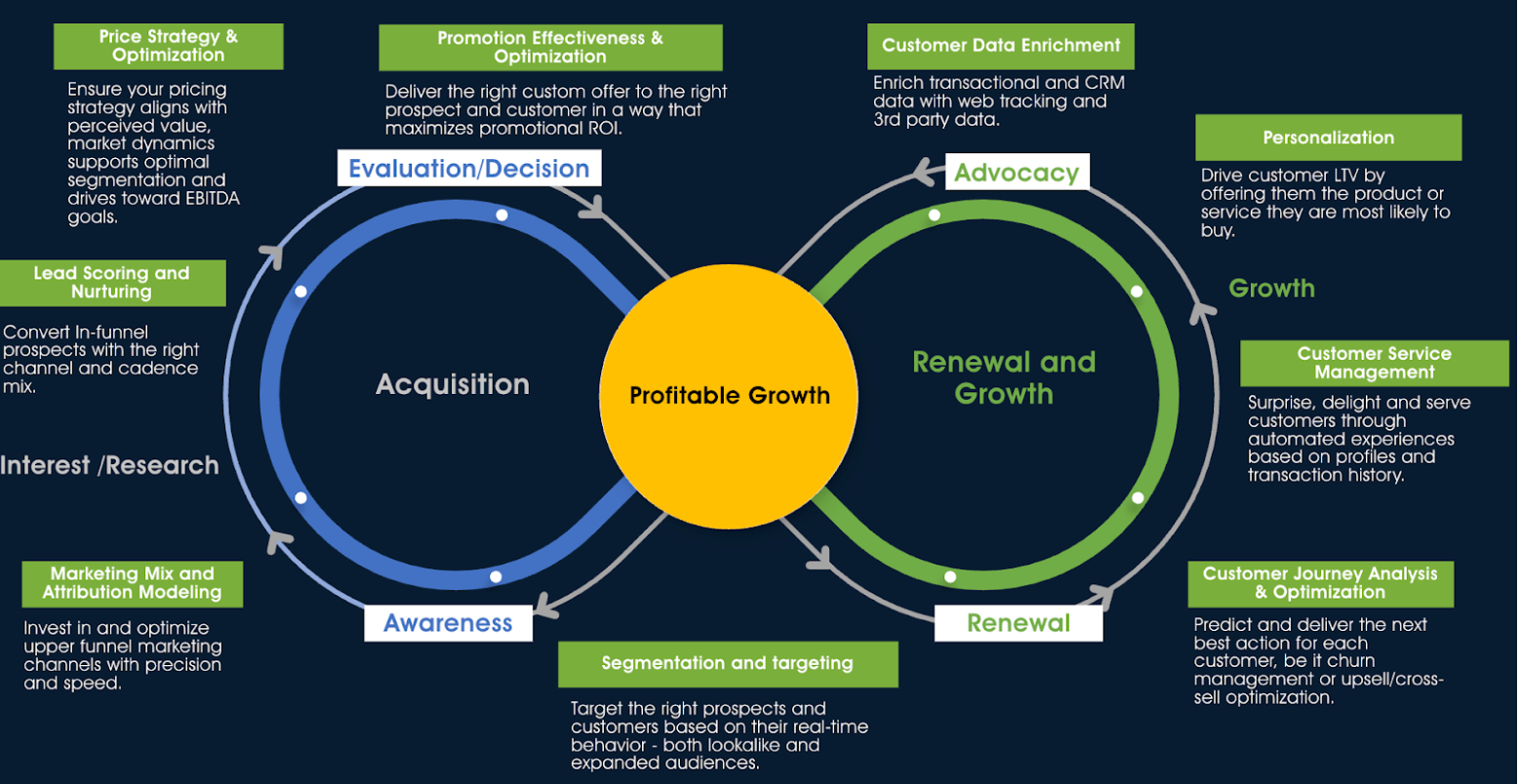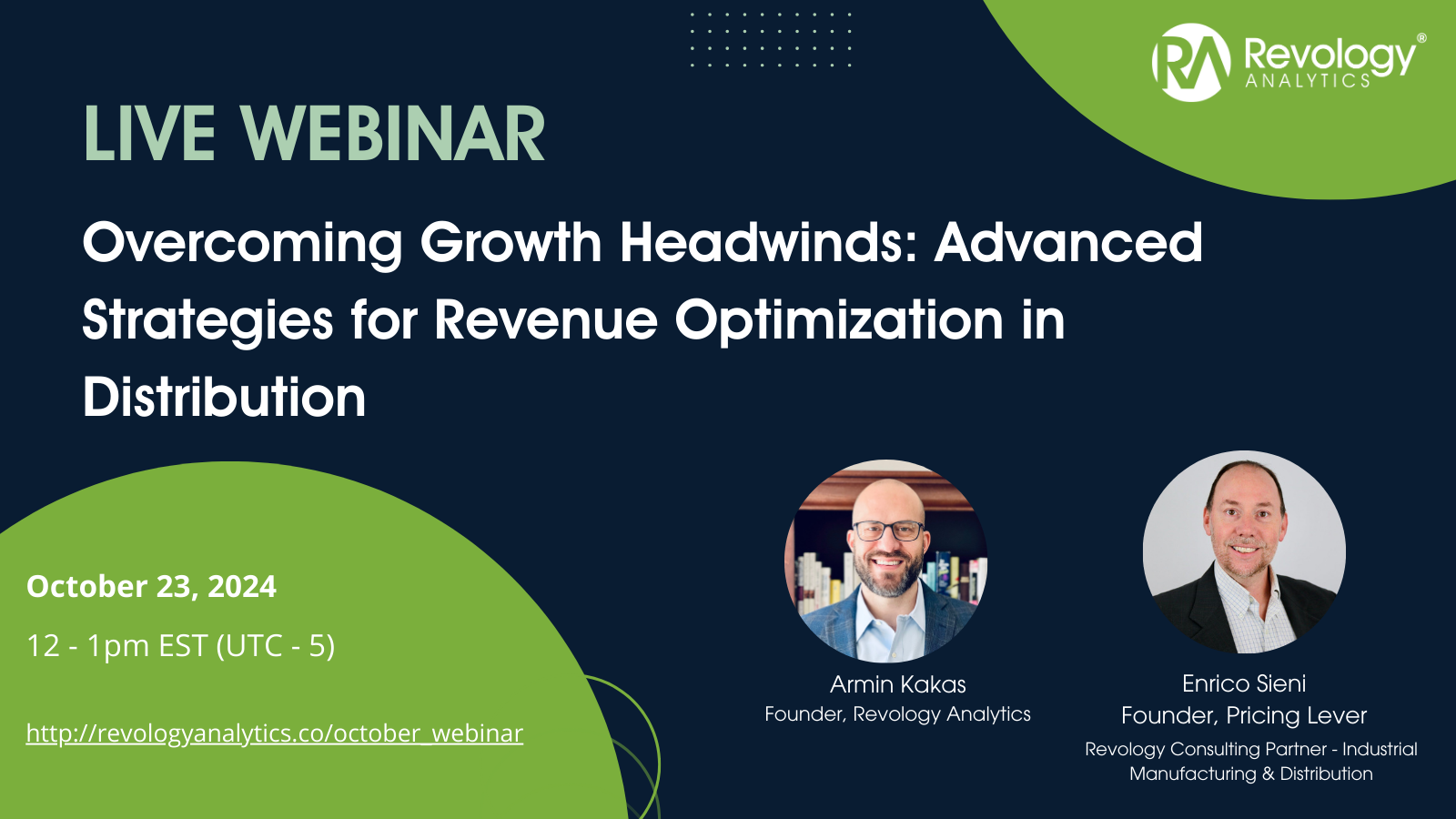Overcoming Growth Headwinds: AI/ML-Driven Strategies for Revenue Optimization in Distribution
Background
The distribution industry is at a pivotal crossroads. Market saturation, escalating competition, and ever-evolving customer expectations have created a complex landscape that demands agility and innovation in Revenue Growth Management (RGM). Despite demonstrating remarkable resilience in navigating supply chain disruptions, fluctuating demand, and economic pressures, many distributors grapple with growth rates that lag behind internal expectations and industry benchmarks. This paradox is perplexing, primarily when data and technological advancements should provide a competitive edge.
Traditional business practices and analytical tools do not address the underlying issues stymieing growth. In a market characterized by slim profit margins and fleeting customer loyalty, distributors must rethink their commercial strategies.
The allure of Artificial Intelligence (AI) and Machine Learning (ML) as the next "shiny objects" can be tempting, but merely adopting these technologies without a solid foundation is a recipe for disappointment. While AI and ML have become table stakes in modern business, their true value lies in pragmatic applications that drive tangible, profitable growth. These capabilities enable the development of smart Revenue Growth Management (RGM) strategies, dynamic pricing models, predictive analytics for customer retention, and highly targeted marketing capabilities.
To thrive, distributors must dive deeper to uncover and tackle the obstacles impeding profitability and organic growth. Three critical areas where net revenue loss is most significant are gaps in price realization, customer churn, and missed opportunities in cross-selling and up-selling.
Pragmatic AI/ML capabilities for Revenue Growth Management in action. We use our universal AI/ML for RGM framework across B2C and B2B industries, but it’s especially relevant in the Distribution industry where Price optimization and Customer Journey Optimization (including churn management, cross-/up-sell, and personalization) are paramount.
Gaps in Price Realization
Price realization—the ability to capture net revenue growth through pricing actions—is crucial yet often overlooked. In decentralized sales processes, individual sales reps may make on-the-spot pricing decisions, offering unplanned discounts and concessions to close deals or appease customers. While a 1% discount might seem negligible, its cumulative effect across numerous transactions can significantly compress profit margins. During cost inflation or deflation periods, missing opportunities to adjust pricing appropriately can exacerbate these gaps, leading to substantial value leakage.
Without robust price elasticity models, these concessions are made without fully understanding their impact on overall profitability. This practice can inadvertently train customers to expect discounts, weakening future pricing power and further squeezing margins. Addressing this issue requires a systematic approach to pricing that balances competitiveness with profitability.
An example of a dynamic Pricing Analytics and Optimization platform built using popular tools like Tableau and Power BI. This Discount Curve Analysis module illustrates sales team behavior in offering discounts to customers - most often defaulting to the highest discounts that they, their manager, or skip-level manager can approve.
Customer Churn
Customer churn—the rate at which customers cease doing business with your company —significantly threatens profitability and blended customer lifetime values. It’s not just about losing a sale; it is about forfeiting future revenue streams and incurring additional costs to acquire new customers. Traditional reporting systems may only flag a customer as lost after they have ceased purchasing altogether, akin to closing the barn door after the horse has bolted.
Customers often exhibit signs of dissatisfaction well before they churn, such as reducing order sizes, increasing intervals between purchases, or expressing more complaints. Without predictive analytics capabilities to identify these patterns, distributors miss critical opportunities to intervene and retain valuable customers. A proactive approach, leveraging data to anticipate churn (including its cause) and mitigating risks before they materialize, is essential.
Missed Cross-Selling and Up-Selling Opportunities
Existing customers represent a goldmine of untapped revenue potential. Failing to cross-sell (offering complementary products) effectively and up-sell (encouraging the purchase of higher-priced items) is a significant missed opportunity. Sales representatives might focus on top “A” or “B” mover products or historical purchasing patterns, neglecting to explore the full range of solutions that could meet customers' needs.
This is particularly vital because distributors typically carry numerous similar products with varying customer pricing and internal profitability. Effective management of product assortments and selling strategies—such as implementing Good-Better-Best techniques—guides customers toward higher-value products, yielding more robust financial results. Without systematic approaches and dynamic, automated tools to guide these efforts, opportunities slip through the cracks, leading to inconsistent customer experiences and opening the door for competitors to fulfill unmet needs.
Navigating Data Challenges
Data is often heralded as the new oil, but its actual value is realized only when effectively processed and analyzed. Distributors face significant hurdles in harnessing data due to issues with data cleanliness, overwhelming data volumes, and limited analytical resources.
Data Cleanliness and Volume
Data quality is the bedrock of any analytical capability. Inaccurate, inconsistent, or incomplete data leads to flawed insights and misguided strategies. Distributors may grapple with data silos, where information is stored in disparate systems that do not communicate effectively. This fragmentation results in duplications and discrepancies, undermining confidence in analytical outputs and hindering decision-making.
The sheer volume of data generated daily—from sales transactions and customer interactions to competitor pricing and supply chain metrics—can be overwhelming. Traditional analytical tools are ill-equipped to handle such massive datasets, resulting in the underutilization of valuable information. Critical patterns and trends remain hidden within the data deluge and are inaccessible when needed.
Limited Analytical Resources
Many distributors lack the specialized expertise to analyze complex data effectively and at scale, turning those insights into commercial capabilities and RGM strategies. Data scientists and advanced analytical platforms represent significant investments. Without them, even data-rich organizations struggle to extract meaningful insights, resulting in missed opportunities to optimize pricing, improve customer retention, or tailor marketing strategies. Implementing insights requires cross-functional collaboration, with teams working closely to bring data insights to life through thorough testing and planned implementations.
Leveraging AI and ML for Competitive Advantage
AI and ML are transforming commercial analytics and revenue growth management. They offer robust solutions to the data challenges faced by distributors, turning obstacles into opportunities for growth and competitive advantage. However, the real power of AI and ML lies in their practical, incremental applications rather than in chasing after the latest technological trends.
Pragmatic Applications Over Shiny Objects
This phenomenon is seen in many companies, including large-cap distributors. Before diving headfirst into AI and ML, it is essential to avoid the temptation of adopting these technologies as mere novelties or chasing some overly ambitious “North Star” type capability. The true value of AI and ML is realized when they are applied pragmatically to drive tangible, profitable growth that you can measure. Focusing on incremental deliverables and quick wins can build confidence within the organization and demonstrate measurable value.
As you start your AI/ML journey with customer segmentation, you can start with more straightforward methods like RFM analysis before augmenting your segmentation using 3rd party firmographic data or applying Natural Language Processing techniques on customer service interactions/transcripts.
AI/ML-Driven Pricing Strategies
Pricing is not just about setting a number; it is a strategic tool that significantly impacts profitability and market positioning. Effective pricing strategies are crucial, especially when margins are thin, and competition is fierce. AI and ML bring a new level of sophistication to price optimization.
Machine learning algorithms can process vast datasets—including historical sales data, customer behavior, competitor pricing, and market trends—to uncover patterns and inform dynamic pricing models. They help in understanding price elasticity, enabling the setting of prices that optimize both sales volume and gross profit. Distributors can increase profit margins by leveraging AI-driven price optimization, improving competitiveness, and customizing pricing strategies that align with customer value perceptions.
Dynamic Pricing Models
Dynamic pricing involves adjusting prices periodically based on current market conditions, demand fluctuations, and competitive activities. While real-time adjustments may not be feasible in a B2B context, implementing weekly or monthly price changes can be practical and less disruptive to customers. AI and ML facilitate dynamic pricing by processing various data inputs to inform pricing decisions in a timely, scalable manner. This proactive approach allows distributors to respond to market changes while maintaining the pricing consistency customers expect.
Dynamic pricing does not have to be complicated. As this example illustrates with markdown pricing, in phase 1, you can focus on automating a certain set of clearance pricing rules that pricing teams would calculate and implement manually. These “rule-based pricing automation” capabilities typically deliver ~ 80-90% of the total value realization relative to true AI–driven dynamic pricing.
Enhancing Customer Retention and Sales
Retaining existing customers and maximizing their lifetime value is more cost-effective than constantly acquiring new ones. AI and ML provide tools to deeply understand customer behavior and personalize interactions to foster loyalty. Machine learning models can identify patterns that precede customer churn by analyzing purchase frequency, order value, engagement levels, and customer service interactions. This enables timely engagement to address issues and reinforce customer relationships.
Proactive retention involves implementing measures designed to reinforce customer loyalty and prevent defection. Effective strategies include personalized communication, loyalty programs, exclusive offers, and exceptional customer service. AI supports these efforts by enabling personalization at scale, automated engagement, and feedback analysis.
Cross-selling and up-selling are critical strategies for increasing revenue without the higher costs of acquiring new customers. AI and ML enhance these strategies by identifying the most relevant products or services to offer each customer. Implementing AI-driven cross-selling and up-selling strategies leads to increased revenue, improved customer satisfaction, and a stronger competitive position.
Implementing AI/ML in Revenue Growth Management
The goal is not to overhaul the entire system overnight but to focus on practical, incremental improvements. By implementing AI and ML capabilities pragmatically—making small, manageable changes—distributors can collectively achieve significant growth.
A Pragmatic Approach to Implementation
It is crucial to start by assessing current capabilities and identifying areas where small changes can make a significant impact. Prioritizing initiatives that offer quick wins and demonstrate measurable value can build momentum. Engaging stakeholders across the organization fosters a data-driven culture, and providing training helps build internal capabilities.
Establishing feedback loops and performance monitoring allows for adapting strategies based on results and evolving business needs. This iterative process ensures that technological advancements align with business fundamentals, driving profitable growth and building a flexible foundation for the future.
Overcoming Implementation Challenges
Adopting AI and ML requires organizational buy-in and addresses potential resistance through effective change management strategies. Leadership must champion these initiatives, emphasizing the importance of incremental improvements and celebrating small wins to maintain enthusiasm. Robust data governance policies are essential to maintain data quality, security, and compliance.
Investing in skill development, whether by training existing staff or hiring specialists, builds the expertise needed for successful implementation. Distributors can avoid the pitfalls of chasing unattainable, grandiose goals by focusing on pragmatic deliverables and incremental wins that drive measurable value.
Charting the Path Forward
The distribution industry is on the cusp of a transformative era. Traditional approaches are no longer sufficient to meet the challenges of a rapidly evolving market. Embracing AI and ML is not a luxury but a necessity and table stakes in this industry. By leveraging these capabilities, distributors can turn vast amounts of data into actionable insights and practical growth strategies.
Implementing the strategies outlined positions distributors to unlock hidden revenue potential, improve profit margins, and foster stronger customer relationships. The path forward requires commitment and investment but offers significant rewards. By adopting AI and ML-driven approaches, distributors can achieve growth rates that exceed expectations, securing a prosperous future and thriving as leaders who set the pace for innovation and excellence.
Join our Exclusive Webinar
Date & Time: October 23, 2024, at 12:00 PM
Unlock full potential and accelerate profitable growth. Register Now
Subscribe to
Revology Analytics Insider
Revenue Growth Analytics thought leadership by Revology?
Use the form below to subscribe to our newsletter.





